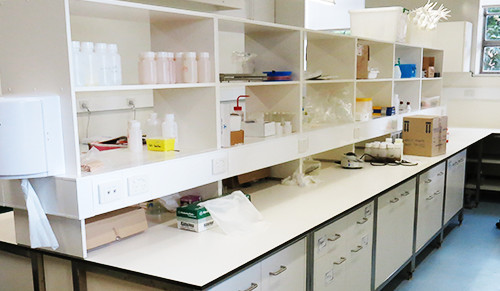Environmental Geochemistry Laboratory

Our Environmental Geochemistry Laboratory provides high-quality research training and elemental analyses for a wide range of disciplines, including:
- geology
- oceanography
- paleoclimatology
- hydrogeology
- coal
- geomicrobiology
- archaeology
- environmental science.
We specialise in high-precision and high-accuracy analysis of trace and ultra-trace elements, including rare earth elements in geological and environmental samples.
The laboratory’s work areas include:
- a balance room
- two acid-resistant fume hoods
- a laminar flow cabinet.
The facility is located in the Richards Building (Building 5) on the Great Court, in what was UQ’s original Geology Museum.
Range of equipment
The Environmental Geochemistry Laboratory houses equipment for the elemental analysis of materials, including those classified as:
- environmental (rocks, sediments, waters)
- synthetic (slag, alloys, pharmaceuticals)
- biological (blood, proteins).
Routine methods for sample digestion include fusion using the state-of-the-art Katanax Automatic Fluxer, hot-plate total or partial digestion and high-pressure bomb digestion. Analyses of major and minor elements are performed either on a Perkin Elmer Optima 8300DV Inductively Coupled Optical Emission Spectrometer (ICP-OES) or the Agilent 7900 Inductively-Coupled Plasma Mass-Spectrometer (ICP-MS).
For more information on analytical methods, download our information sheet about Environmental Geochemistry Laboratory procedures (PDF, 66.2 KB).
The laboratory analytical instrumentation is complemented by various portable instruments and equipment for the collection of field data. These include pH and electrical conductivity meters, equipment for water collection and sample preservation, and a RAD7 analyser for the determination of 222Rn content in water.
For more details about each piece of equipment, see the table below.
Availability
The laboratory facilities are available to UQ staff and students.
We also provide analytical services and research support to external users such as the Geological Survey of Queensland, mining companies and other entities.
For more information, email our Operational Manager, Dr Ai Nguyen, at a.nguyen3@uq.edu.au.
Prices
Instrumentation and facilities
Agilent 7900 Inductively-Coupled Plasma Mass-Spectrometer (ICP-MS)
- This powerful, automated quadrupole ICP-MS uses innovative technology and a new MassHunter software platform.
- The matrix tolerance has been extended into the tens of % total dissolved solids (TDS) range, allowing you to measure samples containing up to 25% TDS.
- Boasts a linear dynamic range of up to 11 orders of magnitude (from sub-ppt to %-level concentrations), as well as a helium collision mode to minimise interference.
- Delivers superior quality data with minimal drift and high precision (below 5%RSD at low ppb levels). Detection levels are in the ppt range.
 Perkin Elmer Optima 8300DV Inductively-Coupled Plasma Optical Emission Spectrometer (ICP-OES)
Perkin Elmer Optima 8300DV Inductively-Coupled Plasma Optical Emission Spectrometer (ICP-OES)
- For routine analysis of major and minor elements.
- Linear over six orders of magnitude (from the ppb to % range) and has an average detection limit of all species in the ppb range.
- Robust and reliable and routinely processes high-matrix materials such as fusions, leachates and brines.
- Download our spreadsheet of quality metrics for the ICP-OES (xlsx, 9.27kB).
Katanax K2 Prime Automatic Fluxer
- Use this heavy-duty, fully-automated electric fusion machine to prepare glass disks (beads) for XRF analysis and solutions for ICP analysis.
- Processes up to six samples simultaneously with a throughput of 24 to 30 samples per hour.
- Typical samples include rocks, minerals and soils.
Acid-cleaning room
- Use this space primarily for equipment cleaning. It is equipped with an acid-scrubbing fumehood and a laminar flow fume cupboard, as well as a milli-Q ultrapure water source.
- To remove any metal contaminants on vessels that you use when preparing and analysing samples, boil the vessels in acid and ultrapure water.
Sample Preparation Laboratory
- This general preparative laboratory provides ample bench space for sample preparation.
- Equipped with a voltammeter, an analytical balance, an IC analyser, two freezers and a sample fridge for storage of samples.
- A variety of consumables and analytical equipment such as micropipettes are available.
Balance room
- Equipped with two digital balances, desiccators, certified reference standards, agate mortar and pestle, micropipettes and all the necessary consumables required for accurately weighing solutions and powdered samples.
